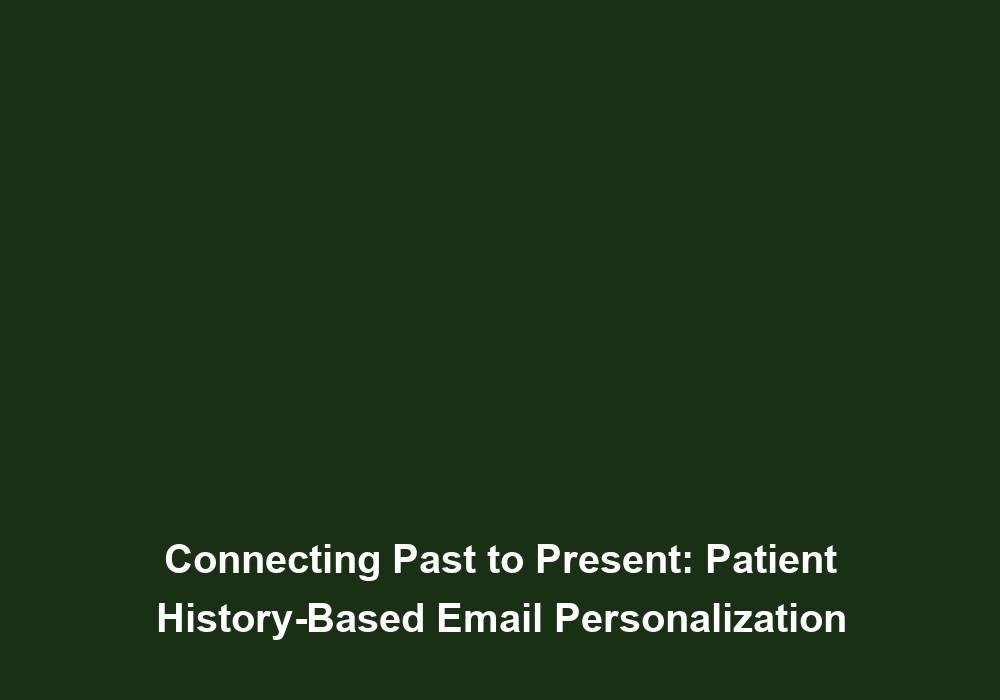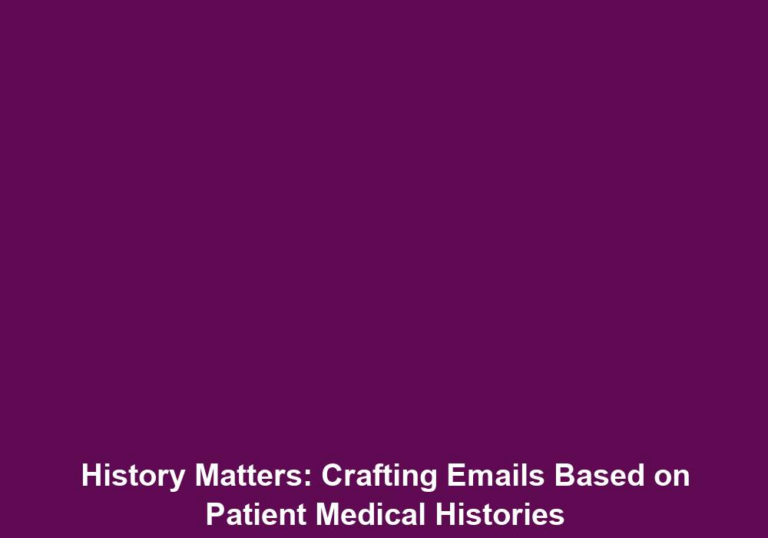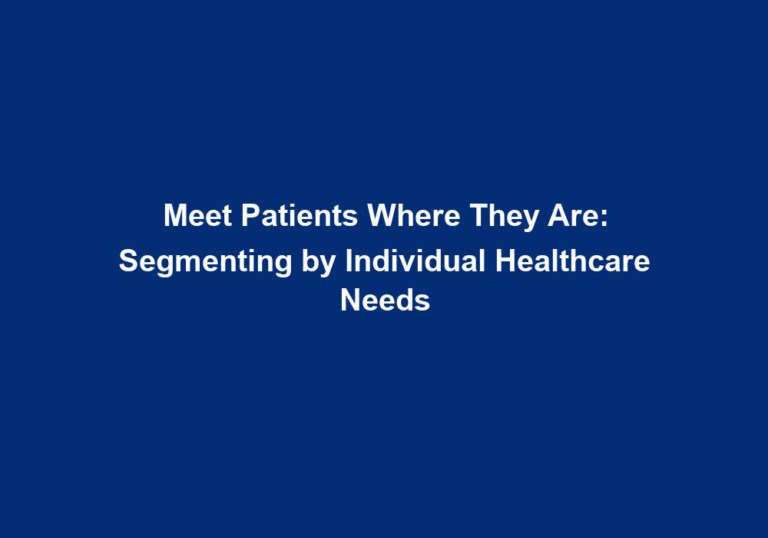Connecting Past to Present: Patient History-Based Email Personalization
In the era of digital marketing, personalization plays a crucial role in engaging customers and driving conversions. Email marketing, as one of the most effective channels, can be enhanced with patient history-based email personalization. By leveraging the wealth of data available in patient history, healthcare providers can deliver tailored and relevant content to their audience. In this article, we will explore the power of patient history-based email personalization and how it can revolutionize healthcare marketing.
Why Patient History Matters
Patient history is a treasure trove of valuable information that can be used to create personalized email campaigns. By understanding a patient’s medical background, preferences, and behavior patterns, healthcare providers can tailor their messages to address specific needs and interests. This level of personalization not only enhances the patient’s experience but also increases the effectiveness of marketing efforts.
Here are some key reasons why patient history matters in email personalization:
- Relevance: Patient history allows healthcare providers to send targeted emails that are relevant to each individual. By focusing on specific medical conditions, treatments, or preventive measures, providers can deliver content that resonates with recipients, increasing the likelihood of engagement.
For example, if a patient has a history of diabetes, an email campaign can include information about managing blood sugar levels, healthy eating habits, and exercise routines. This personalized approach ensures that the content is directly applicable to the recipient’s situation, making it more likely to be read and acted upon.
- Trust and Credibility: When patients receive personalized emails that address their unique concerns and health needs, it boosts their confidence in the healthcare provider. By demonstrating a deep understanding of their history, healthcare providers establish trust and credibility, fostering long-term patient relationships.
By tailoring emails to specific conditions or treatments, healthcare providers show that they are knowledgeable about the patient’s individual needs. This level of personalization creates a sense of trust and reassurance, as patients feel that their healthcare provider truly cares about their well-being.
- Improved Patient Outcomes: Personalized emails based on patient history can educate and empower individuals to make informed decisions about their health. By providing relevant and timely information, healthcare providers can contribute to better patient outcomes and overall well-being.
For instance, if a patient has a history of heart disease, personalized emails can include tips for managing cholesterol levels, maintaining a heart-healthy diet, and incorporating exercise into daily routines. By empowering patients with knowledge and resources, healthcare providers can support them in making positive lifestyle choices that lead to improved health outcomes.
Leveraging Patient History for Email Personalization
Now that we understand the importance of patient history in email personalization, let’s delve into practical strategies for leveraging this data effectively:
1. Segmentation
Segmentation is a fundamental step in email personalization. By categorizing patients into distinct groups based on their demographics, medical conditions, or treatment history, healthcare providers can deliver tailored content to each segment. This allows for more precise targeting and higher engagement rates.
Some potential segmentation criteria include:
- Age and gender: Different age groups may have different healthcare needs and concerns. By segmenting patients based on age and gender, providers can send emails that are specifically tailored to their unique requirements.
- Medical conditions or diagnoses: Segmenting patients based on medical conditions or diagnoses allows healthcare providers to provide relevant information and resources related to those specific health issues.
- Treatment history: Patients who have undergone specific treatments may require follow-up information or reminders. Segmenting based on treatment history ensures that these patients receive the appropriate content.
- Medication usage: Patients who are taking specific medications may benefit from receiving emails about potential side effects, drug interactions, or reminders for refills.
- Allergies: Segmenting patients based on allergies allows healthcare providers to send emails that take into account any potential allergic reactions to certain medications or treatments.
By segmenting patients and tailoring emails accordingly, healthcare providers can ensure that the content they deliver is highly relevant to each individual, increasing the chances of engagement and conversion.
2. Dynamic Content
Dynamic content refers to elements within an email that change based on the recipient’s profile or behavior. By dynamically populating emails with personalized information, healthcare providers can create a more engaging and relevant experience.
For example, an email could include the patient’s name, upcoming appointment details, or relevant educational resources specific to their medical condition. By incorporating such personalized elements, healthcare providers can make the email feel more personalized and tailored to the recipient’s needs.
Additionally, dynamic content can also be used to deliver time-sensitive information. For instance, if a patient is due for a follow-up appointment or needs to schedule a preventive screening, the email can dynamically generate a reminder with options for scheduling.
By leveraging dynamic content, healthcare providers can create highly personalized and engaging emails that resonate with recipients, increasing the likelihood of interaction and response.
3. Behavioral Triggers
Behavioral triggers are automated email responses triggered by specific actions or events. By monitoring patient behavior, such as website visits, appointment scheduling, or medication adherence, healthcare providers can send timely and personalized emails.
For instance, if a patient misses an appointment, an automated email reminder can be sent with rescheduling options. If a patient visits a specific webpage related to a particular medical condition, an automated email can be triggered, providing additional information or resources on that topic.
By leveraging behavioral triggers, healthcare providers can ensure that patients receive relevant and timely information, enhancing their overall experience and engagement with the healthcare organization.
4. Tailored Recommendations
Based on a patient’s medical history, healthcare providers can offer tailored recommendations for preventive care, screenings, or follow-up treatments. By proactively reaching out to patients with personalized recommendations, providers can promote proactive healthcare and nurture patient relationships.
For example, if a patient has a history of high blood pressure, the healthcare provider can send personalized recommendations for lifestyle modifications, such as reducing sodium intake and engaging in regular exercise. By providing these tailored recommendations, healthcare providers can support patients in managing their health effectively and prevent future complications.
5. Patient Education
Emails based on patient history can serve as a powerful educational tool. Healthcare providers can create email campaigns that provide valuable information about specific medical conditions, treatment options, or lifestyle modifications.
By educating patients through personalized content, providers can empower individuals to take control of their health. For instance, emails can include educational resources such as articles, videos, or infographics that explain complex medical concepts in a simple and accessible manner. By providing patients with the knowledge they need to make informed decisions, healthcare providers can contribute to improved patient outcomes and overall well-being.
Best Practices for Patient History-Based Email Personalization
To ensure successful implementation of patient history-based email personalization, here are some best practices to consider:
-
Data Privacy and Security: Patient data is sensitive, and healthcare providers must prioritize privacy and security when collecting, storing, and utilizing patient history for email personalization. Compliance with relevant regulations, such as HIPAA, is crucial to maintain patient trust.
-
Consent Management: Obtain explicit consent from patients to use their data for email personalization. Implement a robust consent management system to ensure transparency and compliance.
-
Continuous Testing and Optimization: Email personalization is an iterative process. Continuously test different variables, such as subject lines, content formats, and calls-to-action, to optimize engagement and conversions.
-
Analytics and Performance Tracking: Monitor and analyze email campaign performance to gain insights into what resonates with patients. Use analytics tools to track open rates, click-through rates, and conversions to refine future email personalization strategies.
By following these best practices, healthcare marketers can maximize the effectiveness of patient history-based email personalization and achieve better engagement and conversion rates.
Conclusion
Patient history-based email personalization opens up new opportunities for healthcare providers to connect with their audience on a deeper level. By leveraging the wealth of data available in patient history, providers can deliver highly relevant and tailored content, leading to increased patient engagement, trust, and improved health outcomes.
Implementing the strategies outlined in this article, along with adhering to best practices, can help healthcare marketers unlock the full potential of patient history-based email personalization. With a personalized approach, healthcare providers can enhance their marketing efforts, build stronger patient relationships, and drive better patient outcomes.







